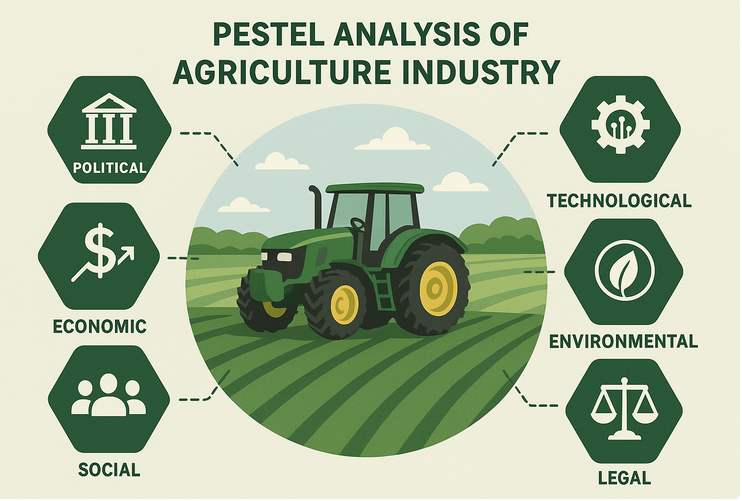The UK footwear industry is a dynamic and highly competitive sector influenced by a range of external macro-environmental factors. As consumer demands evolve and global market conditions shift, businesses in this industry must navigate challenges such as changing political landscapes, economic uncertainty, and increasing environmental concerns. A PESTLE analysis provides a strategic framework to assess the key Political, Economic, Social, Technological, Legal, and Environmental factors shaping the industry’s current performance and future outlook. Understanding these elements is essential for brands, retailers, and manufacturers to adapt, innovate, and stay competitive in the UK’s fast-paced footwear market.
Political Factors – UK Footwear Industry
-
Post-Brexit Trade Policies:
The UK’s departure from the European Union has introduced new tariffs, customs procedures, and regulatory differences that affect the import and export of footwear. Since many shoes are manufactured abroad (especially in Asia or Europe), this increases costs and complicates supply chains. -
Government Support and Incentives:
The UK government has introduced schemes to support British manufacturing and small fashion businesses, including grants, tax relief, and local production incentives. This benefits domestic footwear brands aiming to reduce import dependency. -
Labour and Employment Regulations:
The industry is influenced by national minimum wage laws, working conditions regulations, and labour rights. These affect operational costs, especially for companies with retail outlets, warehouses, and manufacturing units in the UK. -
Political Stability:
While the UK is generally politically stable, uncertainties related to elections, changes in trade agreements, or public policy (e.g., environmental laws) can influence business planning and investment in the footwear sector. -
International Trade Relations:
Political relationships with key footwear-producing countries like China, India, and Vietnam impact import policies, tariffs, and logistics. Any diplomatic tensions or sanctions could affect the steady supply of products or raw materials. -
Regulations on Ethical Sourcing:
Political pressure to ensure ethical sourcing, such as anti-slavery laws and supply chain transparency, is increasing. Brands are now required to disclose working conditions and labour practices in their global supply chains.
Economic Factors – UK Footwear Industry
-
Inflation and Cost of Living Crisis:
Ongoing inflation and rising living costs in the UK have led consumers to reduce discretionary spending. This affects demand for non-essential items like fashion footwear, especially premium or luxury products. -
Fluctuating Exchange Rates:
The value of the British pound affects the cost of imported footwear and materials. A weaker pound increases import costs, squeezing profit margins for retailers and brands relying on foreign manufacturing. -
Wage Growth and Employment Trends:
Higher wages and low unemployment in some areas can boost spending power, benefiting the footwear market. However, rising wages also increase operational costs for retailers, logistics providers, and manufacturers. -
E-commerce Growth and Digital Transformation:
The shift to online shopping has lowered entry barriers for new footwear brands and reshaped consumer behavior. However, it also intensifies competition and demands heavy investment in digital platforms and logistics. -
Global Supply Chain Disruptions:
Economic disruptions like increased shipping costs, port delays, and material shortages have affected supply chains. This results in higher prices and product delays for UK retailers and consumers. -
Consumer Preference for Value:
In times of economic uncertainty, customers shift towards affordable, durable, and multi-purpose footwear. This benefits value-driven brands and discount retailers over premium or fashion-first labels. -
Interest Rates and Borrowing Costs:
Rising interest rates make borrowing more expensive for businesses, reducing investment in expansion, technology, or new product lines. It also affects consumer credit spending on non-essentials like shoes.
Social Factors – UK Footwear Industry
-
Changing Consumer Preferences:
UK consumers are increasingly prioritizing comfort, functionality, and sustainability in footwear choices. This trend is shifting demand away from purely fashion-driven designs toward everyday, health-conscious, and eco-friendly products. -
Sustainability and Ethical Consumerism:
A growing number of consumers, especially Gen Z and Millennials, are demanding footwear that is ethically made, cruelty-free, and environmentally sustainable. Brands that offer vegan, recyclable, or locally made shoes are gaining popularity. -
Health and Wellness Trends:
The rise in health awareness has increased demand for sports shoes, orthopaedic footwear, and supportive walking shoes. This trend is driven by both younger fitness-focused consumers and older age groups with foot care needs. -
Influence of Social Media and Celebrities:
Platforms like Instagram, TikTok, and YouTube play a key role in shaping footwear trends. Influencer collaborations and viral marketing can quickly boost demand for specific styles or brands. -
Diversity and Inclusion:
There’s growing demand for inclusive sizing, gender-neutral designs, and adaptive footwear for people with disabilities. Brands embracing inclusivity are viewed more favorably by the public. -
Rise of Fast Fashion Culture:
Although under criticism, fast fashion continues to influence short-term consumer demand for trendy and affordable footwear, especially among younger shoppers. This creates high turnover but raises environmental concerns. -
Urban Lifestyle and Work Trends:
Hybrid working models and casual dress codes have reduced the demand for formal footwear and increased the popularity of sneakers, slip-ons, and casual boots.
Technological Factors – UK Footwear Industry
-
E-commerce and Digital Platforms:
The rise of online shopping has transformed how footwear is marketed and sold. User-friendly websites, mobile apps, and online marketplaces now dominate the consumer experience, making digital investment crucial for competitiveness. -
Augmented Reality (AR) and Virtual Try-Ons:
Technologies like AR allow customers to virtually try on shoes using their smartphones. This enhances the online shopping experience, reduces returns, and increases customer satisfaction. -
3D Printing and Customization:
3D printing enables the production of customized and made-to-order footwear with greater precision and less waste. This innovation is especially relevant for sportswear and orthopaedic shoe brands. -
Automation and Smart Manufacturing:
Footwear production is becoming more automated with robotics and AI, improving speed, quality control, and cost efficiency. Brands investing in smart factories can reduce reliance on offshore manufacturing. -
Big Data and AI in Retail:
Retailers use data analytics to understand consumer behavior, manage inventory, and personalize marketing campaigns. AI-driven recommendations boost online sales and customer engagement. -
Supply Chain Technology:
Technologies like blockchain, RFID tagging, and real-time logistics tracking help streamline supply chains, reduce losses, and improve transparency — critical for ethical sourcing and sustainability. -
Social Media and Influencer Tech Tools:
Tools for influencer marketing, digital advertising, and trend tracking allow brands to connect directly with consumers and quickly adapt to emerging fashion trends.
Legal Factors – UK Footwear Industry
-
Product Safety and Quality Regulations:
Footwear products sold in the UK must meet strict safety and quality standards under laws like the Consumer Protection Act. Materials, labeling, and construction must comply with legal guidelines to avoid recalls or penalties. -
Employment and Labour Laws:
Businesses must comply with UK employment laws, including minimum wage regulations, working hour limits, and employee rights. Retailers and manufacturers are especially affected due to their large workforces in stores and warehouses. -
Intellectual Property (IP) Protection:
Brands must protect their designs, logos, and trademarks from counterfeiting and copycats. Legal action against infringement is common in the fashion footwear industry, particularly for high-end or iconic shoe designs. -
Advertising Standards and Consumer Rights:
All marketing and advertising must comply with the Advertising Standards Authority (ASA) rules and the Consumer Rights Act. Misleading claims about materials, sustainability, or performance can lead to legal consequences. -
Sustainability and Supply Chain Laws:
Laws like the UK Modern Slavery Act require companies to ensure transparency in their supply chains and avoid human rights violations. Footwear brands must conduct ethical sourcing audits and publish compliance statements. -
Post-Brexit Regulatory Changes:
Divergence from EU regulations means that UK-specific compliance is now required for products, including UKCA (UK Conformity Assessed) marking instead of the former CE mark used under EU rules. -
E-commerce and Data Protection Laws:
Online retailers must comply with data privacy laws such as the UK GDPR, covering how customer data is collected, stored, and used. Violations can result in heavy fines and damage to brand reputation.
Environmental Factors – UK Footwear Industry
-
Sustainability Pressure:
Consumers, regulators, and activists are increasingly demanding that footwear brands reduce their environmental impact. This includes minimizing carbon emissions, using eco-friendly materials, and adopting sustainable manufacturing practices. -
Waste and Landfill Concerns:
The UK produces thousands of tonnes of discarded footwear annually. The industry faces growing pressure to address end-of-life product management through recycling schemes, repair services, and take-back programs. -
Packaging Regulations:
New UK regulations are being introduced to reduce single-use plastics and non-recyclable packaging. Footwear companies are expected to use biodegradable or recyclable packaging materials to meet legal and consumer expectations. -
Climate Change and Resource Scarcity:
Global warming and extreme weather events disrupt global supply chains, especially in countries where raw materials like leather or rubber are sourced. This leads to higher costs and supply instability. -
Eco-Labeling and Transparency:
Environmental labeling (e.g., carbon footprint, material origin) is becoming a requirement. Brands must provide clear information about how their products impact the environment, particularly when making sustainability claims. -
Green Innovation and Circular Economy:
The shift toward a circular economy encourages the development of recyclable, biodegradable, or modular footwear. Some brands are adopting closed-loop systems where used shoes are returned and remade into new products. -
Regulatory Compliance:
The UK government is enforcing stricter environmental regulations, including emissions targets and waste reduction goals. Non-compliance may result in fines or restrictions on product sales.
Conclusion: PESTLE Analysis of the UK Footwear Industry
The UK footwear industry operates in a complex environment shaped by a range of external macroeconomic and socio-political factors. Political changes like Brexit and evolving trade policies have altered supply chain dynamics, while economic challenges such as inflation and shifting consumer spending patterns demand greater adaptability from brands. Social trends emphasising sustainability, comfort, and inclusivity are reshaping consumer expectations, and technological innovations are transforming retail, production, and customer engagement. Legal obligations around labour, product safety, and digital privacy, alongside growing environmental concerns, are pushing footwear companies toward more ethical and sustainable business models. To remain competitive and resilient, UK footwear brands must continue to innovate, comply with evolving regulations, and align closely with consumer values and global sustainability goals.





Leave a Reply